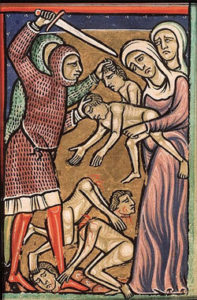December 28, the Feast of the Holy Innocents, commemorates the murder of the male babies of Bethlehem by King Herod. In England the day was known as Childermas (or Dyzemas) and was considered an ill-omened time; few would want, for example, to be married on that date. Not only was no business conducted on that day, but the day of the week on which it fell was deemed unlucky for the rest of the year. In Ireland it was Lá Crostna na Bliana, the “cross day of the year” when no new enterprise was begun. Many sailors would not sail on that day; on the Aran isles no one was buried on Childermas (or the day of the week on which it occurred); and in Cornwall to wash on that day was to doom one of your relatives to death.
Childermas was also a day for ritual beatings. The seventeenth-century writer Gregorie notes the custom of whipping children in the morning of that day so that Herod’s murderousness “might stick the closer; and, in a moderate proportion, to act over the crueltie again in kind.”

The part of the entire Nativity that always fascinated me most (aside, of course, from the importance of the day itself) was that of the Magi and Herod.
The Magi always held a peculiar glamor for me. They are the great puzzle — Biblical hints about them are tantalizing for their brevity and opacity.
But clearly the Magi held sufficient weight for Herod to take them and their visions seriously.
Herod, of course, came to a bad end. But what of the Magi… how did they live the rest of their lives, having witnessed the birth of Christ? I just wish there was more known about them.